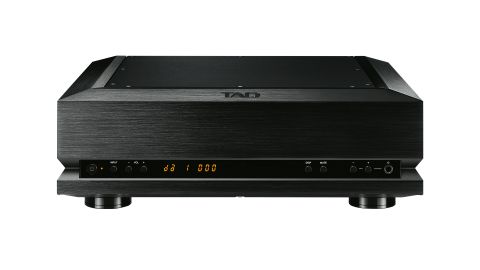The year was 1975 and Pioneer was developing a new range of high-end speakers specifically designed for professional use. The project was called TAD, and the initials stood, rather unimaginatively, for Technical Audio Devices. TAD continued to develop as a sub-brand until it was separated from Pioneer and established as a standalone company in 2007.
Today, TAD has developed into a respected high-end manufacturer of speakers and electronics, and the new DA1000TX digital-to-analogue converter is a fine example of what the company does. Like many of TAD’s designs, it is an understated product, built and engineered with obsessive care.
Build
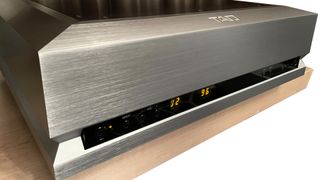
When we say understated, that doesn’t apply to the size of the thing. It is easily bigger than many of the premium power amplifiers that pass through our test rooms and weighs in at a hefty 16.5kg. Best make sure your hi-fi rack is strong enough to support it.
Yet, get past the bulk and you’ll find that TAD has a thing for simplicity. The DA1000TX’s front panel is pleasingly uncluttered with all the controls sitting in the dark strip near the base of the unit. There is a small, basic but clear display alongside a few scattered buttons to control the volume level, toggle through inputs and switch power on. Couch potatoes need not worry, TAD also supplies a rather nice metal remote for those that would rather not have to get up to change things. This remote is as uncluttered and easy to use as the main unit.
Features
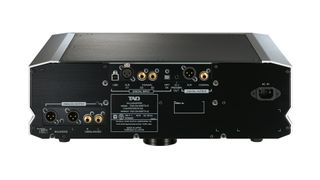
The brand’s focused simplicity-first approach extends to the way the unit operates. While most DAC rivals offer a multitude of filter settings and other adjustments to allow users to tweak performance, TAD takes a more dictatorial approach by offering nothing in the way of fine-tuning. You hear what the engineers consider best. It is a brave move, but also one that speaks of the company’s conviction in its approach to sound quality.
Connectivity is good, with the usual trio of USB (type B), coax (x2) and optical digital inputs present alongside the less commonly seen AES/EBU option. There is also a pair of digital outputs for those that want the option of doing extra processing. On the analogue side, there is the standard choice of balanced XLR and single-ended RCA outputs, and on the front panel you will find a 6.3mm headphone socket. The DA1000TX is unconventional in that plugging a pair of headphones in doesn’t mute its line output. The headphone and line-level outputs are controlled independently, which is handy at times but also takes a bit of getting used to.
Take a look inside the DA1000TX and you’ll find an immaculately constructed product with dual-differential DAC ICs per channel alongside independent power supplies for the analogue and digital sections of the circuitry to minimise unwanted interaction. Great care is taken with the master clock signal to minimise jitter and the general circuit design to reduce noise levels.
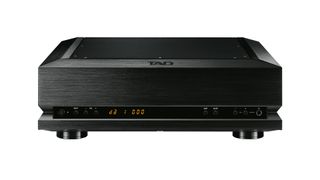
Max file compatibility 32-bit/384kHz PCM, DSD256
Digital inputs USB Type B, AES/EBU, coax x2, optical
Digital outputs AES/EBU, coax
Analogue outputs Stereo RCA, stereo balanced XLR, 6.3mm headphone out
Remote? Yes
Weight 16.5kg
Dimensions (hwd) 15 x 44 x 41cm
TAD has gone to the trouble and expense of developing its own asynchronous USB engine. Most rivals buy third-party off-the-shelf modules to do the job, which potentially gives the DA1000TX a performance advantage in this area. As always, the proof is in the listening.
This DAC can handle pretty much any audio file type you like from 32-bit/384kHz PCM to DSD256. We certainly didn’t come across any compatibility issues with our music collection, though completists would probably want to add MQA decoding ability to the spec sheet. Our only complaint here is that we hear a slight click coming through our speakers every time we change file types. Surely TAD could mute this? Other companies can.
Any product at this level demands a top-class system, and this DAC is no different. We use a Naim ND555/555 PS DR as our main digital source and have a MacBook Pro (loaded with Audirvana music-playing software) on hand to test the USB input. We also have a Chord 2go/2yu available as an alternative digital source. The rest of our reference system consists of Burmester’s 088/911 Mk III amplifier and ATC SCM50 speakers all connected with premium cables from Chord and Vertere.
Sound
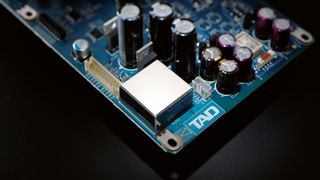
The DA1000TX delivers an impressive performance once it settles into our system. It has an excellent analogue output section, and it isn’t long before we bypass our 088 preamp and plug the TAD straight into our Burmester power amplifier. The sound is obviously clearer and more neutral with this configuration but still retains a good sense of authority; this is a quality that tends to get sacrificed when using most class rivals in this way.
We would describe the TAD’s sound as clean, precise and cultured. It has a sophisticated presentation that digs up plenty of detail and organises it into a musically coherent performance. Play a demanding recording such as Mahler’s Symphony No.4 and the DAC responds with a wide open soundstage populated with crisply drawn instruments. There is a good sense of depth here and stereo imaging stays stable even when the piece becomes demanding. The sense of scale is pleasing and extends our system’s sounds well beyond the outside edges of the ATCs.
This is not a particularly characterful sound, and that’s a compliment. The DA1000TX doesn’t go out to colour the presentation to make it sound more interesting; it is balanced, neutral and revealing. That also means less-than-perfect recordings are ruthlessly exposed, though the TAD’s innate refinement means it stops short of making a meal of things. We’re impressed by the composure on show and the way this DAC can render delicate instrumental textures so gracefully.
We switch to Nick Cave's Babe, I’m On Fire from 2003’s Nocturama set and continue to be impressed. This is a full-throttle recording and the DA1000TX’s agility and articulation come to the fore. There is so much going on in this production but the TAD keeps things under control well. We love this DAC’s top-to-bottom cohesion and the way it can track multiple instrumental strands without losing grip. There is subtlety in the way Cave’s exuberant vocals are drawn and real clarity in a recording that usually sounds pretty messy.
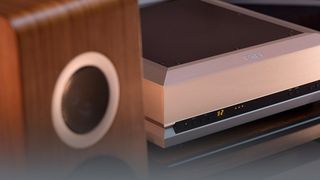
We’re pleased to report that the sound is equally good through the headphone output. We try a range of headphones from Focal’s Utopia and the Sony MDR-Z1 to Grado’s RS1x, and the TAD drives them without issue, letting the individual character of each shine through. We can ask no more than that.
Despite all these great things, there are still a few areas where we feel there is space for improvement. One of them concerns rhythmic drive. There is real momentum to Cave’s Babe, I’m On Fire but the DA1000TX doesn’t quite capture that energy. Our feet are still tapping but we know the similarly-priced Chord DAVE would capture more of the verve and drive of the track. It seems TAD’s search for refinement, analysis and control has sacrificed a little of the music’s fun in the process. That includes the way it pulls its punches when it comes to delivering the leading edge of transients and powerful large-scale dynamic shifts. This DAC prefers to err on the side of politeness, and on some more aggressive forms of music, we can feel the loss.
Verdict
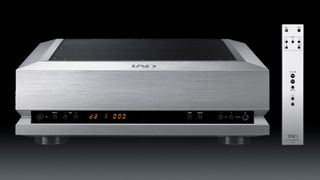
Overall though, we like the TAD DA1000TX. It is a hugely capable unit and really is beautifully made and engineered. If you are the kind of person who values sophistication and refinement over brio, it really is worth a listen.
SCORES
- Sound 4
- Build 5
- Features 5
MORE:
Read our review of the Chord DAVE
Also consider the dCS Bartók
Best DACs: USB, portable and desktop digital-to-analogue converters
